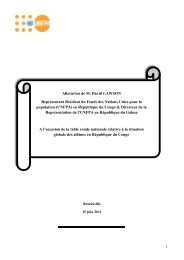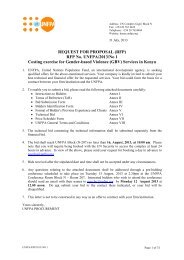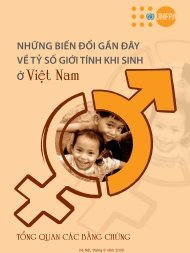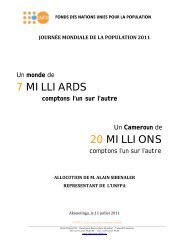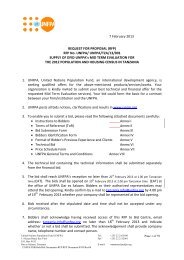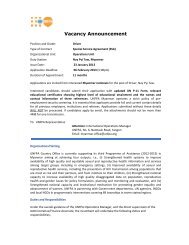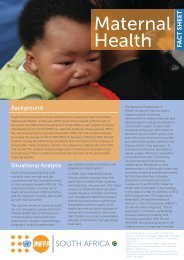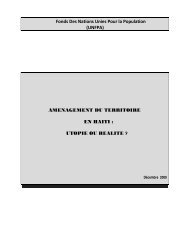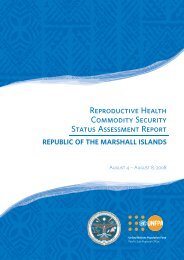A reproductive health needs assessment in Myanmar
A reproductive health needs assessment in Myanmar
A reproductive health needs assessment in Myanmar
Create successful ePaper yourself
Turn your PDF publications into a flip-book with our unique Google optimized e-Paper software.
A Reproductive Health Needs Assessment <strong>in</strong> <strong>Myanmar</strong><br />
exists to prevent these <strong>in</strong>fections - the <strong>in</strong>stillation of eyedrops immediately after birth -<br />
current <strong>in</strong>ternational recommendations are that all newborn <strong>in</strong>fants receive presumptive<br />
treatment to prevent ophthalmia neonatorum. This was not reported to be rout<strong>in</strong>e practice<br />
among TBAs, AMWs, midwives, or hospitals <strong>in</strong> facilities visited dur<strong>in</strong>g the <strong>assessment</strong>.<br />
National guidel<strong>in</strong>es regard<strong>in</strong>g the importance of adm<strong>in</strong>ister<strong>in</strong>g ophthalmia<br />
neonatorum prophylaxis for all newborn <strong>in</strong>fants should be developed and<br />
dissem<strong>in</strong>ated widely to all <strong>health</strong> staff who provide care for newborn <strong>in</strong>fants. Given<br />
the high social costs associated with preventable bl<strong>in</strong>dness, consideration should be<br />
given to public subsidy of such prophylaxis.<br />
Research <strong>needs</strong><br />
International experience suggests that the task of develop<strong>in</strong>g standardised case management<br />
guidel<strong>in</strong>es for symptomatic RTIs is greatly simplified by the availability of accurate<br />
prevalence data regard<strong>in</strong>g the most common pathogens associated with the various RTI<br />
syndromes. At present very little data are available concern<strong>in</strong>g RTI prevalence <strong>in</strong> <strong>Myanmar</strong>.<br />
Better data are needed regard<strong>in</strong>g the prevalence of RTIs, <strong>in</strong>clud<strong>in</strong>g both STDs and<br />
endogenous <strong>in</strong>fections. Studies should focus on those client populations most <strong>in</strong> need of<br />
RTI case management, for example, clients of private GPs, women seek<strong>in</strong>g services at<br />
rural and urban <strong>health</strong> centres, and men and women attend<strong>in</strong>g STD cl<strong>in</strong>ics. Broaden<strong>in</strong>g<br />
the test<strong>in</strong>g for syphilis <strong>in</strong> rout<strong>in</strong>ely collected blood samples drawn for the semi-annual<br />
HIV sent<strong>in</strong>el surveillance programme would be desirable.<br />
Decid<strong>in</strong>g which antibiotics to recommend as part of the national RTI treatment guidel<strong>in</strong>es<br />
requires a careful consideration of the cost, likelihood of patient compliance, and<br />
effectiveness of various antibiotic for the treatment of various RTI syndromes.<br />
There is a need for periodic studies of the antimicrobial resistance of gonorrhoea <strong>in</strong><br />
order to <strong>in</strong>form the selection of antibiotics for standardized RTI case management<br />
guidel<strong>in</strong>es.<br />
Once standardized flowcharts have been developed it is important to validate them among the<br />
client populations for which they will be used. Experience from other countries suggests that<br />
variations <strong>in</strong> the epidemiology of RTIs require flowcharts that are adapted to the national<br />
context. Some flowcharts have been found to result <strong>in</strong> significant over-treatment with<br />
antibiotic therapy, a unnecessary expense that potentially contributes to <strong>in</strong>creased<br />
antimicrobial resistance.<br />
Research is needed to validate the RTI flowcharts recommended as part of standardized<br />
case management guidel<strong>in</strong>es.<br />
Several recent studies suggest that a number of <strong>in</strong>terventions may be partially effective <strong>in</strong><br />
reduc<strong>in</strong>g the per<strong>in</strong>atal transmission of HIV from mothers to newborns. This <strong>in</strong>cludes<br />
provid<strong>in</strong>g safe alternatives to breastmilk for HIV <strong>in</strong>fected women, as well as the<br />
adm<strong>in</strong>istration of antiretroviral drugs <strong>in</strong> the peripartum period. The cost and operational<br />
feasibility of this strategy for use <strong>in</strong> <strong>Myanmar</strong> has yet to be explored.<br />
73




